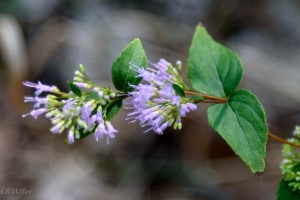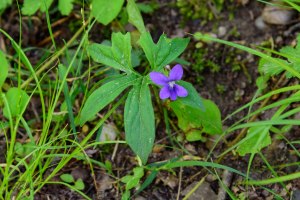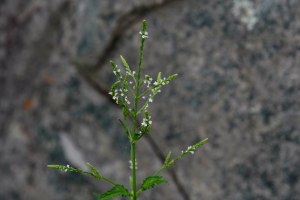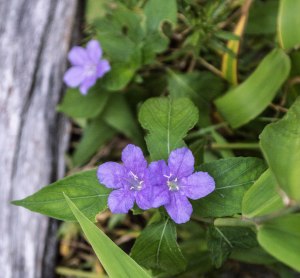Continuing with pretty pictures during this cold season. It’s a thin line between blue and purple. Color is a continuum. Color is in the eye of the beholder. If some of these look more blue or pink than purple, well, c’est la vie.
 Triodanis perfoliata (Venus’ looking glass; Campanulaceae)
Triodanis perfoliata (Venus’ looking glass; Campanulaceae)
Look for this annual forb growing in rocky places where there isn’t much competition from other plants. It generally blooms from about mid May into early June here in the Maryland piedmont.
 Clinopodium vulgare (wild basil; Lamiaceae)
Clinopodium vulgare (wild basil; Lamiaceae)
A perennial forb with circumboreal distribution. Look for the flowers in the height of summer.
Cunila origanoides (common dittany; Lamiaceae)
A perennial native to North America, and found mostly in the mid West and mid Atlantic. It blooms in late summer.
Elephantopus caroliniana (Carolina elephant’s foot; Asteraceae)
A rather weedy-looking plant with a fascinating inflorescence. Click on the picture and look closely; you’ll see that this is actually four disk flowers, each with a five-lobed corolla. The species is native to the southeastern US (Maryland is almost as far north as it goes). It blooms in late summer.
Eutrochium purpureum (sweet joe-pye weed; Asteraceae).
The joe-pye weeds (formerly Eupatorium species) are perennials that love wet places, but this particular species tolerates drier soils and is a great native for the home garden, with dramatic heads of colorful flowers towering above most other forbs. And it attracts butterflies. Blooms in late summer.
 Mentha arvensis (field mint; Lamiaceae)
Mentha arvensis (field mint; Lamiaceae)
Another mint-family plant with circumboreal distribution. Another late-summer bloomer.
 Mimulus alatus (winged monkeyflower; Phrymaceae)
Mimulus alatus (winged monkeyflower; Phrymaceae)
Watch for this wetland plant and its almost identical cousin M. ringens var. ringens (Allegheny monkeyflower) blooming in early to mid summer.
Monarda fistulosa (wild bergamot; Lamiaceae)
The mint family sure is represented well here. Look for it in mid summer, possibly covered in bees and butterflies.
Phlox divaricata (woodland phlox, wild blue phlox; Polemoniaceae)
As you can see this flower ranges from almost white through lighter and stronger shades of blue and purple. They bloom at about the same time as Virginia bluebells. Bluebells grow in the floodplain while this phlox grows just upland of the floodplain, in still moist (but not wet) woodland soils.
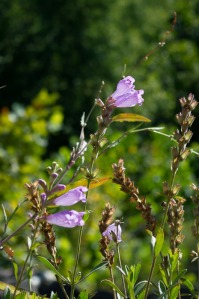 Physostegia virginiana (obedient plant; Lamiaceae)
Physostegia virginiana (obedient plant; Lamiaceae)
Yet another mint family mid summer bloomer. Watch for it on rocky outcrops and gravel bars in the Potomac.
 Ruellia caroliniensis (hairy wild petunia; Acanthaceae)
Ruellia caroliniensis (hairy wild petunia; Acanthaceae)
In Maryland this species is found mostly in the Coastal Plain; in the piedmont it’s restricted to a few sites near the Potomac River (as far as I know – please leave a comment if you know otherwise). Watch for it in late spring and early summer.
 Trichostema dichotomum (forked bluecurls; Lamiaceae)
Trichostema dichotomum (forked bluecurls; Lamiaceae)
Blue or purple, or splitting the difference? Whatever. This is a most striking plant, one of those OMG finds. Well it was for me, anyway. What a lurid color. Late summer, dry soils, open areas. Yow.
Verbena hastata (blue vervain, swamp verbena, Verbenaceae)
As one of the common names suggests, you’ll find this in wetlands, blooming anywhere from late June to mid August. This is an extreme closeup; the plants are rather tall but the inflorescences rather small.
Vernonia noveboracensis (New York ironweed; Asteraceae)
All ray flowers with strongly exserted stigmas, no disk flowers. Very tall plant, wispy appearance. Likes wet soils. Blooms in mid to late summer.
Viola palmata (early blue violet, three-loved violet; Violaceae)
Violet taxonomy is in flux, and violet species can be difficult to differentiate. This one is relatively easy because of the unusual leaf shape, although even that can be highly variable. Look for it in mid spring in drier woodlands.

